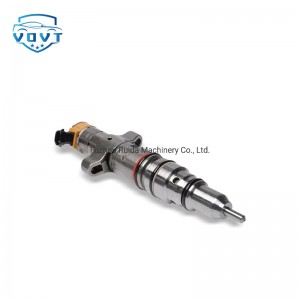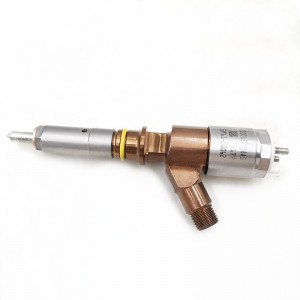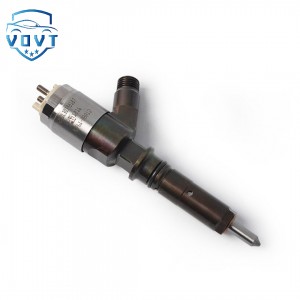New High Quality Diesel Injector 7C-4184 0R-0906 7C-9576 0R-1759 7C-9577 0R-1758 7C-9578 0R-1756 For CAT 3500A
Products Description
| Reference. Codes | 3500A |
| Application | 3500A |
| MOQ | 4PCS |
| Certification | ISO9001 |
| Place of Origin | China |
| Packaging | Neutral packing |
| Quality Control | 100% tested before shipment |
| Lead time | 7~10 working days |
| Payment | T/T, L/C, Paypal, Western Union, MoneyGram or as your requirement |
The role of the injector
The injector is one of the core components of the fuel supply system of an internal combustion engine (such as a gasoline engine and a diesel engine). Its function is to inject the fuel to a specified location (such as the intake manifold and the combustion chamber) at a precise flow rate, pressure and atomization state according to the engine's operating conditions (such as speed, load, temperature, etc.), thereby achieving efficient combustion of the fuel and improving the engine's power, economy and emission performance. The specific functions can be expanded from the following aspects:
Accurately control the amount of fuel injection
Core function: According to the instructions of the engine ECU (electronic control unit), the fuel injection amount is accurately adjusted by controlling the opening time (injection pulse width) and opening frequency of the injector, so that the air-fuel ratio (mass ratio of air to fuel) is always kept within the ideal range (such as the theoretical air-fuel ratio of a gasoline engine is 14.7:1).
Application scenarios:
Idle condition: The amount of fuel injection is small and stable, maintaining the lowest engine speed.
Full load condition: The amount of fuel injection is the largest, ensuring the maximum power output of the engine.
Transition conditions (such as acceleration and deceleration): adjust the injection amount in real time to avoid power lag or emission deterioration caused by too rich or too lean mixture.
Provide appropriate injection pressure
Working principle: The solenoid valve or hydraulic mechanism inside the injector pushes the needle valve to open through high-pressure fuel (such as the pressure of the diesel common rail system can reach more than 200MPa), and the fuel is sprayed out at high pressure.
Key influence:
Atomization effect: High-pressure injection breaks the fuel into finer particles (particle size can be up to micron level), increases the contact area between fuel and air, and accelerates mixing and combustion.
Penetration ability: Sufficient pressure ensures that the fuel effectively penetrates the air resistance in the combustion chamber or intake manifold and reaches the target position (such as direct injection of diesel engines requires penetration of compressed air).
Optimize fuel atomization and mixing
Atomization mechanism: The structure of the injector nozzle (such as hole nozzle, pintle nozzle, valve nozzle) and the spray hole design (aperture, number of holes, injection angle) directly determine the atomization form of the fuel.
Hole-type nozzle: mostly used in diesel engines, with small spray holes (0.1-0.3mm), cone-shaped spray oil beam, fine atomized particles, suitable for high-pressure direct injection.
Pin-type nozzle: mostly used for gasoline engine intake manifold injection, the spray hole surrounds the pin to form an annular gap, the oil beam is hollow cone-shaped, the atomization is uniform and not easy to clog.
Mixing efficiency: Reasonable atomization form can make the fuel and air quickly form a uniform combustible mixture, reduce the local rich mixture area in the combustion chamber, and reduce hydrocarbon (HC) and particulate matter (PM) emissions.
Adapt to different combustion modes
Gasoline engine injector:
Manifold injection (PFI): The injector is installed in the intake manifold, and the fuel is injected before the intake stroke, and enters the combustion chamber after premixing with the air, which is suitable for uniform combustion.
Direct injection (GDI): The injector directly sprays high-pressure fuel into the combustion chamber, cooperates with the top pit of the piston and the airflow movement, to achieve stratified combustion or homogeneous combustion, and improve fuel economy.
Diesel engine injector:
Using a high-pressure common rail system, the injector can achieve multiple injections (such as pre-injection, main injection, and post-injection) according to load requirements, optimize the combustion process, and reduce nitrogen oxides (NOx) and noise.
Improve the overall performance of the engine
1. Power
Precise fuel injection ensures full combustion, releases more energy, and improves engine torque and power output. For example, a diesel engine high-pressure common rail injector can reduce fuel consumption by 15%-20% and increase power by 10%-20%.
2. Economy
Avoid fuel waste by adjusting the injection amount and injection timing in real time. For example, a gasoline engine uses lean combustion (the air-fuel ratio is greater than the theoretical value) at partial load, which can further reduce fuel consumption.
3. Emission
The optimized atomization and mixing process reduces the generation of unburned fuel and harmful substances. With the electronic control system and post-processing devices (such as three-way catalytic converters and DPF particulate filters), it can meet stringent emission regulations such as National VI and Euro VII.
Typical Faults and Impacts
If the performance of the injector is abnormal, the following problems may occur in the engine:
Blockage or leakage: Blockage of the spray hole will cause poor atomization and missing cylinders; leakage of the seal may cause fuel dripping, causing difficulty in starting or abnormal combustion (such as knocking).
Insufficient injection pressure: Poor fuel penetration and uneven mixture will lead to power decline and excessive emissions.
Control failure: The ECU cannot accurately control the amount of fuel injection, which may cause unstable idle speed, weak acceleration or a surge in fuel consumption.
Summary
The injector is a "bridge" connecting the fuel supply system and the combustion process, and its performance directly determines the combustion efficiency and working characteristics of the engine. With the tightening of emission regulations and the development of new energy technologies, the injector is evolving towards **higher pressure (such as more than 300MPa for diesel engines), more precise control (such as nanosecond response time of solenoid valves), and more reliable and durable (long-life materials).** At the same time, it will also play a key role in new power systems such as hydrogen fuel engines and methanol engines.























